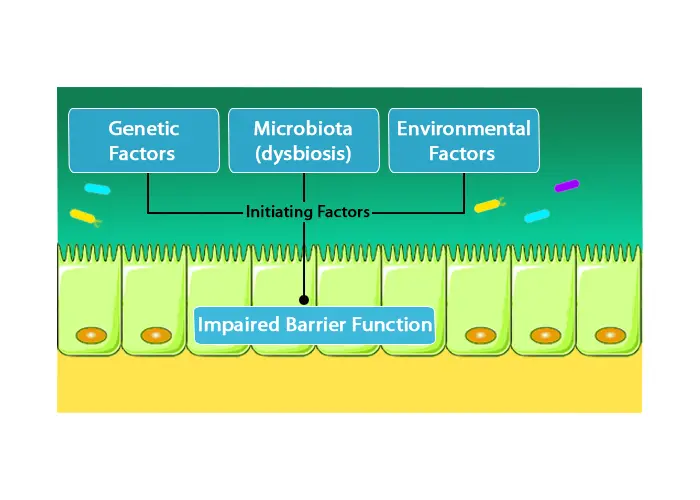If you are diagnosed with Inflammatory Bowel Disease (IBD), one of the most frequent questions that you may ask is, “What happens in the gut that causes the inflammation and constant bowel issues?” In this article, we will review the mechanisms involved in the development of IBD disease.

Inflammatory bowel disease is a chronic relapsing condition characterized by inflammation of gastrointestinal (GI) tract. It is comprised of two main conditions: Ulcerative Colitis and Crohn’s Disease. These two conditions share many symptoms and risk factors, yet they are quite different. One major difference is the involvement of digestive tract. Crohn’s can involve any part of the gastrointestinal tract, whereas Ulcerative colitis involves the colon.
IBD affects an estimated 3 million people in America. Although, it can affect people of all ethnic backgrounds, the disease is more prevalent among Caucasians.
Like any other autoimmune condition, this condition occurs when the body’s immune system attacks your healthy tissues leading to inflammation. IBD occurs when the fine balance between tolerance and inflammation in the gastrointestinal tract is disrupted. The natural process of digestion is affected because of an inflamed, swollen and ulcerated digestive system.
Full understanding of why the disease develops is not completely known. This makes IBD challenging to diagnose and treat. But the components involved in the disease development are made up of environmental, genetic, microbial and immunological factors.
In the images below, you can see the mucosal layer of the gut to understand the disease development of IBD.
 |  |
Mucosal layer of the intestine
The innermost layer of the intestines is the mucosal layer, which surrounds the inner open space, or the cavity of the intestine, called the lumen. Within the lumen is the gut microbiome consisting mainly of bacteria. The mucosal layer is made up of the outer mucus layer, inner mucus layer, epithelium, connective tissue surrounding the epithelium, and smooth muscle layer which surrounds the connective tissue. Organisms, including bacteria and food antigens, are prevented from entering the intestine by the mucosal layer in people without Crohn’s or Colitis conditions. The effective barrier requires an intact intestinal epithelium.

What happens in people with IBD?
In people with Inflammatory bowel disease, evidence indicates that the development of IBD is due to:
- Improper immune response to the bacteria that enters the lamina propria (connective tissue) through the changes in the epithelium
- Alteration in both the composition and function of intestinal microbes (Dysbiosis)
- Genetic variations in the pathways important in maintaining intestinal inflammation
The mechanism in the underlying development of IBD is considered to be an overactive mucosal immune response to gut microbes in genetically susceptible people. The overactive mucosal immune response leads to a swollen, inflamed gut with ulcers and related symptoms, such as diarrhea, abdominal pain, urgency in passing bowel movements, fatigue, loss of appetite and weight loss.
These mechanisms involved in the development of IBD are the basis of targeting therapies.
Large amounts of inflammatory mediators, interferon (IFN)-gamma and tumor necrosis factor (TNF)-alpha, are secreted in people with IBD. This is the basis of the development of biologics. Biologics work by inhibiting these inflammatory mediators.
5-Aminosalicylates are steroids used in the treatment of IBD due to their anti-inflammatory properties.
Immunosuppressants, often reserved for severe Crohn’s or Colitis, act by suppressing immunity, and thereby, reducing inflammation.
The ongoing exploration of the benefits of prebiotics and probiotics is based on their ability to restore healthy gut microbiota.
IBD cannot be prevented or cured. The goal of the treatment is to manage symptoms, reduce severity of the disease, and minimize the number of flares (active disease).
You can control your inflammation by adhering to the medications prescribed by your doctor, managing your stress, and maintaining a healthy lifestyle. The KnowYourMeds app can carefully monitor and track symptoms every day to help you recognize a flare-up as soon as it begins.


